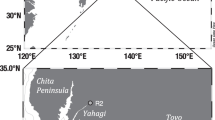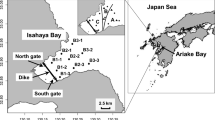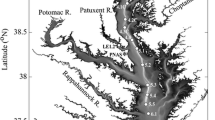Abstract
The northern Gulf of Mexico (NGOMEX) was surveyed to examine the broad-scale spatial patterns and inter-relationships between hypoxia (<2 mg L−1 dissolved oxygen) and zooplankton biovolume. We used an undulating towed body equipped with sensors for conductivity, temperature, depth, oxygen, fluorescence, and an optical plankton counter to sample water column structure, oxygen, and zooplankton at high spatial resolution (1 m—vertical; 0.25–1 km—horizontal). We contrast the distribution of zooplankton during summer surveys with different freshwater input, stratification, and horizontal and vertical extent of bottom-water hypoxia. Bottom-water hypoxia did not appear to influence the total amount of zooplankton biomass present in the water column or the areal integration of zooplankton standing stock in the NGOMEX region surveyed. However, where there were hypoxic bottom waters, zooplankton shifted their vertical distribution to the upper water column during the day where they normally would reside in deeper and darker waters. When bottom waters were normoxic (>2 mg L−1 dissolved oxygen), the daytime median depth of the water column zooplankton was on average 7 m deeper than the median depth of zooplankton in water columns with hypoxic bottom waters. A reduction in larger zooplankton when there were hypoxic bottom waters suggests that if zooplankton cannot migrate to deeper, darker water under hypoxic conditions, they may be more susceptible to size-selective predation by visual predators. Thus, habitat compression in the northern Gulf of Mexico due to hypoxic bottom water may have implications for trophic transfer by increasing the contact between predators and prey.







Similar content being viewed by others
References
Aku, P.M., L.G. Rudstam, and W.M. Tonn. 1997. Impact of hypolimnetic oxygenation on the vertical distribution of cisco (Coregonus artedi) in Amisk Lake, Alberta. Canadian Journal of Fisheries and Aquatic Sciences 54: 2182–2195.
Bianchi, T.S., S.F. DiMarco, J.H. Cowan Jr., R.D. Hetland, P. Chapman, J.W. Day, and M.A. Allison. 2010. The science of hypoxia in the Northern Gulf of Mexico: a review. Science of the Total Environment 408: 1471–1484.
Breitburg, D.L., T. Loher, C.A. Pacey, and A. Gerstein. 1997. Varying effects of low dissolved oxygen on trophic interactions in an estuarine food web. Ecological Monographs 67: 489–507.
Breitburg, D.L., L. Pihl, and S.E. Kolesar. 2001. Effects of low dissolved oxygen on the behavior, ecology and harvest of fishes: a comparison of the Chesapeake and Baltic systems. In Coastal hypoxia: consequences for living resources and ecosystems, ed. N.N. Rabalais and R.E. Turner, 241–267. Washington, DC: American Geophysical Union.
Chin-Leo, G., and R. Benner. 1992. Enhanced bacterioplankton production and respiration at intermediate salinities in the Mississippi River plume. Marine Ecology Progress Series 82: 87–103.
Cloern, J.E. 2001. Our evolving conceptual model of the coastal eutrophication problem. Marine Ecology Progress Series 210: 223–253.
Coutant, C.C. 1985. Striped bass, temperature, and dissolved oxygen: a speculative hypothesis for environmental risk. Transactions of the American Fisheries Society 114: 31–62.
Craig, J.K. 2012. Aggregation on the edge: effects of hypoxia avoidance on the spatial distribution of brown shrimp and demersal fishes in the Northern Gulf of Mexico. Marine Ecology Progress Series 445: 75–95.
Dagg, M.J. 1995. Copepod grazing and the fate of phytoplankton in the northern Gulf of Mexico. Continental Shelf Research 15: 1303–1317.
Dagg, M.J., and G.A. Breed. 2003. Biological effects of Mississippi River nitrogen on the northern Gulf of Mexico—a review and synthesis. Journal of Marine Systems 43: 133–152.
Dagg, M.J., and T.E. Whitledge. 1991. Concentrations of copepod nauplii associated with the nutrient-rich plume of the Mississippi River. Continental Shelf Research 11: 1409–1423.
Diaz, R.J., and R. Rosenberg. 1995. Marine benthic hypoxia: a review of its ecological effects and the behavioral responses of benthic macrofauna. Oceanography and Marine Biology Annual Review 33: 245–303.
Diaz, R.J., and R. Rosenberg. 2008. Spreading dead zones and consequences for marine ecosystems. Science 321: 926–929.
Elliott, D.T., J.J. Pierson, and M.R. Roman. 2012. Relationship between environmental conditions and zooplankton community structure during summer hypoxia in the northern Gulf of Mexico. Journal of Plankton Research. doi:10.1093/plankt/fbs029.
Graham, W.M. 2001. Numerical increases and distributional shifts of Chrysaora quinquecirrha (Desor) and Aurelia aurita (Linne) (Cnidaria: Scyphozoa) in the northern Gulf of Mexico. Hydrobiologia 451: 97–111.
Hazen, E.L., J.K. Craig, C.P. Good, and L.B. Crowder. 2009. Vertical distribution of fish biomass in hypoxic waters on the Gulf of Mexico shelf. Marine Ecology Progress Series 375: 195–207.
Herman, A.W. 1988. Simultaneous measurement of zooplankton and light attenuance with a new optical plankton counter. Continental Shelf Research 8: 205–221.
Herman, A.W. 1992. Design and calibration of a new optical plankton counter capable of sizing small zooplankton. Deep Sea Research 39: 395–415.
Howarth, R.W., D. Anderson, T. Church, H. Greening, C. Hopkinson, W. Huber, N. Marcus, R. Naiman, K. Segerson, A. Sharpley, and W. Wiseman. 2000. Clean coastal waters—understanding and reducing the effects of nutrient pollution. Washington, DC: National Academy of Sciences. 405 pp.
Huntley, M.E., M. Zhou, and W. Nordhausen. 1995. Mesoscale distribution of zooplankton in the California Current in late spring, observed by optical plankton counter. Journal of Marine Research 53: 647–674.
Keister, J.E., E.D. Houde, and D.L. Breitburg. 2000. Effects of bottom-layer hypoxia on abundances and depth distributions of organisms in Patuxent River, Chesapeake Bay. Marine Ecology Progress Series 205: 43–59.
Kimmel, D.G., M.R. Roman, and X. Zhang. 2006. Spatial and temporal variability in factors controlling mesozooplankton dynamics in Chesapeake Bay: evidence from biomass size spectra. Limnology and Oceanography 51: 131–141.
Kimmel, D.G., W.C. Boicourt, J.J. Pierson, M.R. Roman, and X. Zhang. 2009. A comparison of the mesozooplankton response to hypoxia in Chesapeake Bay and the northern Gulf of Mexico using the biomass size spectrum. Journal of Experimental Marine Biology and Ecology 381: S65–S73.
Kimmel, D.G., W. Boicourt, J. Pierson, M. Roman, and X. Zhang. 2010. The vertical distribution and diel variability of mesozooplankton biomass, abundance and size in response to hypoxia in the northern Gulf of Mexico, USA. Journal of Plankton Research 32: 1185–1202.
Klumb, R.A., K.L. Bunch, E.L. Mills, L.G. Rudstam, G. Brown, C. Knauf, R. Burton, and F. Arrhenius. 2004. Establishment of a metalimnetic oxygen refuge for zooplankton in a productive Lake Ontario embayment. Ecological Applications 14: 113–131.
Kolar, C.S., and F.J. Rahel. 1993. Interaction of a biotic factor (predator presence) and an abiotic factor (low oxygen) as an influence on benthic invertebrate communities. Oecologia 95: 210–219.
Liu, H., and M. Dagg. 2003. Interactions between nutrients, phytoplankton growth, and grazing by micro- and meso-zooplankton in the plume of a large river. Marine Ecology Progress Series 258: 31–42.
Lohrenz, S.E., M.L. Dagg, and T.E. Whitledge. 1990. Enhanced primary production at the plume/oceanic interface of the Mississippi River. Continental Shelf Research 10: 639–664.
Lohrenz, S.E., G.L. Fahenstiuel, D.G. Redalje, G.A. Lang, X. Chen, and M.J. Dagg. 1997. Variations in primary production of northern Gulf of Mexico continental shelf waters linked to nutrient inputs from the Mississippi River. Marine Ecology Progress Series 155: 45–54.
Ludsin, S.A., X. Zhang, S.B. Brandt, M.R. Roman, W.C. Boicourt, D.M. Mason, and M. Costantini. 2009. Hypoxia-avoidance by planktivorous fish in Chesapeake Bay: implications for food web interactions and fish recruitment. Journal of Experimental Marine Biology and Ecology 381: S121–S131.
Marcus, N.H., C. Richmond, C. Sedlacek, G.A. Miller, and C. Oppert. 2004. Impact of hypoxia on the survival, egg production and population dynamics of Acartia tonsa Dana. Journal of Experimental Marine Biology and Ecology 301: 111–128.
Mauchline, J. 1998. The biology of calanoid copepods. Advances in Marine Biology 23: 710.
Nixon, S.W. 1990. Marine eutrophication—a growing international problem. Ambio 19: 101–101.
Ortner, P.B., L.C. Hill, and S.R. Cummings. 1989. Zooplankton community structure and copepod species composition in the northern Gulf of Mexico. Continental Shelf Research 9: 387–402.
Pierson, J.J., M.R. Roman, D.G. Kimmel, W.C. Boicourt, and X. Zhang. 2009. Quantifying changes in the vertical distribution of mesozooplankton in response to hypoxic bottom waters. Journal of Experimental Marine Biology and Ecology 381: S74–S79.
Prince, E.D., and C.P. Goodyear. 2006. Hypoxia-based habitat compression of tropical pelagic fishes. Fisheries Oceanography 15: 451–464.
Qureshi, N.A., and N.N. Rabalais. 2001. Distribution of zooplankton on a seasonally hypoxic continental shelf. In Coastal hypoxia: consequences for living resources and ecosystems, ed. N.N. Rabalais and R.E. Turner, 61–76. Washington, DC: American Geophysical Union.
Rabalais, N.N., and R.E. Turner. 2001. Hypoxia in the northern Gulf of Mexico: description, causes and change. In Coastal hypoxia: consequences for living resources and ecosystems, ed. N.N. Rabalais and R.E. Turner, 1–36. Washington, DC: American Geophysical Union.
Rabalais, N.N., R.E. Turner, D. Justic, Q. Dortch, W.J. Wiseman, and B.K. Sen Gupta. 1996. Nutrient changes in the Mississippi River and system responses on the adjacent continental shelf. Estuaries 19: 386–407.
Rabalais, N.N., R.E. Turner, and W.J. Wiseman. 2002. Gulf of Mexico, aka “the dead zone”. Annual Review of Ecology and Systematics 33: 235–263.
Roman, M.R., A.L. Gauzens, W.K. Rhinehart, and J.R. White. 1993. Effects of low oxygen waters on Chesapeake Bay zooplankton. Limnology and Oceanography 38: 1603–1614.
Roman, M., X. Zhang, C. McGilliard, and W. Boicourt. 2005. Seasonal and annual variability in the spatial patterns of plankton biomass in Chesapeake Bay. Limnology and Oceanography 50: 480–492.
Sprules, W.G., E.H. Jin, A.W. Herman, et al. 1998. Calibration of an optical plankton counter for use in fresh water. Limnology and Oceanography 43: 726–733.
Stow, C.A., S.S. Qian, and J.K. Craig. 2005. Declining threshold for hypoxia in the Gulf of Mexico. Environmental Science and Technology 39: 716–723.
Taylor, J.C., P.S. Rand, and J. Jenkins. 2007. Swimming behavior of juvenile anchovies (Anchoa spp.) in an episodically hypoxic estuary: implications for individual energetics and trophic dynamics. Marine Biology 152: 939–957.
Turner, R.E., and N.N. Rabalais. 1994. Coastal eutrophication near the Mississippi River delta. Nature 368: 619–621.
U.S. Department of Commerce. 2008. Fisheries of the United States 2008. Current Fisheries Statistics, No. 2008, 103 pp.
Wannamaker, C.M., and J.A. Rice. 2000. Effects of hypoxia on movements and behavior of selected estuarine organisms from the southeastern United States. Journal of Experimental Marine Biology and Ecology 249: 145–163.
Wu, R.S. 2002. Hypoxia: from molecular responses to ecosystem responses. Marine Pollution Bulletin 45: 35–45.
Yentsch, C.S., and D.W. Menzel. 1963. A method for the determination of phytoplankton chlorophyll-a and phaeophytin by fluorescence. Deep Sea Research 10: 21–231.
Zhang, X., M. Roman, A. Sanford, H. Adolf, C. Lascara, and R. Burgett. 2000. Can an optical plankton counter produce reasonable estimates of zooplankton abundance and biovolume in water with high detritus? Journal of Plankton Research 22: 137–150.
Zhang, X., M. Roman, D. Kimmel, C. McGilliard, and W. Boicourt. 2006. Spatial variability in plankton biomass and hydrographic variables along an axial transect in Chesapeake Bay. Journal of Geophysical Research—Oceans 111: C05S11.
Zhang, H., S.A. Ludsin, D.M. Mason, A.T. Adamack, S.B. Brandt, X. Zhang, D.G. Kimmel, M.R. Roman, and W.C. Boicourt. 2009. Hypoxia-driven changes in the behavior and spatial distribution of pelagic fish and zooplankton in the northern Gulf of Mexico. Journal of Experimental Marine Biology and Ecology 381: S80–S91.
Acknowledgments
We thank M. Brooks, C. Derry, K. Hozyash, D. Kennedy, B. Loveland, A. Spear, and T. Wazniak for technical assistance and Nancy Rabalais for facilitating the research. We thank the captain and crew of the R/V Pelican. This work was supported by NOAA Awards NA06NOS4780148 and NA09N0S4780198. This is UMCES Contribution #4677 and NGOMEX Contribution #161.
Author information
Authors and Affiliations
Corresponding author
Rights and permissions
About this article
Cite this article
Roman, M.R., Pierson, J.J., Kimmel, D.G. et al. Impacts of Hypoxia on Zooplankton Spatial Distributions in the Northern Gulf of Mexico. Estuaries and Coasts 35, 1261–1269 (2012). https://doi.org/10.1007/s12237-012-9531-x
Received:
Revised:
Accepted:
Published:
Issue Date:
DOI: https://doi.org/10.1007/s12237-012-9531-x




